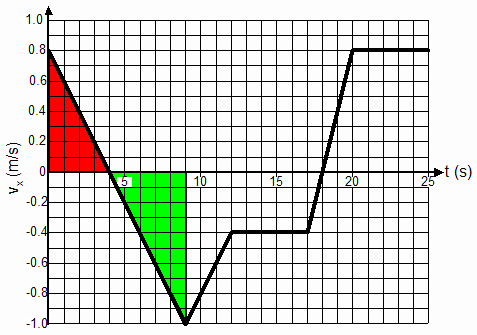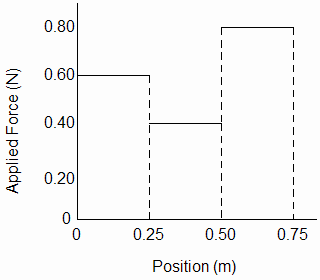Guide 7-2. Work as the Area Under a Graph of Force vs. Position
Introduction
Interpreting graphs is an important skill in physics. You've already encountered this with position, velocity, and acceleration vs. time graphs. You saw that the slopes of the position vs. time and velocity vs. time graphs had special meanings. (If you've had or are taking calculus, you probably realized that we were just talking about derivatives.) Another characteristic of graphs that has special meaning in some cases is the area under the line on the graph. Consider this problem: The velocity vs. time graph in Figure 1 represents the motion of an object. Find the displacement of the object from t = 0 to 9.0 s if the position at t = 0 was 2.0 m. Solution: The area under the line from t = 0 to 9.0 s is the displacement of the object during that time interval. We calculate the area simply by summing the areas of the red and green triangles in Figure 2. The calculation is shown below the figures.
| Figure 1 | Figure 2 |
 |
 |
Displacement = Area of Red Triangle + Area of Green Triangle
= (0.80 m/s)(4.0 s)/2 + (-1.0 m/s)(5.0 s)/2
= -0.9 m
Since the object's initial position was 2.0 m, it's final position is 1.1 m. Note that the area below the line is negative. This makes sense, because the object is traveling back toward its starting point. (If you've taken calculus, you recognized that by finding area, we were just finding the integral of the velocity over time.)
Another example of the use of the area under the line in kinematics is that of an acceleration vs. time graph. In that case, the area under the line is the change in velocity of the object.
Force vs. Position Examples
Work Example 1. Now let's go on to an example involving a force vs. position graph. For such graphs, the area under the line is the work done by the force. This is also discussed in section 7-3 of the text. Let's look at problem 28 at the end of the chapter as an example. Figure 3 below shows the force applied to an object as a function of the object's position. The goal is to find the work done by the applied force as the object moves from x = 0 to x = 0.75 m. The method of solution is simply to sum the areas of the green, blue, and red rectangles shown in Figure 4. This is done below the figures.
| Figure 3 | Figure 4 |
 |
 |
We write for the work done by the applied force

Note the use of the compact summation
notation signified by the upper case sigma, ![]() .
This simply means to add the force-displacement products for strips 1 to
3. Note also that we haven't included a cosθ
term for the force displacement product. That's because this is a
one-dimensional situation. The force and displacement will either be
parallel or anti-parallel. If we take F to represent a magnitude, then
the positive or negative sign for the parallel or anti-parallel cases is
introduced by the sign of the displacement. If positions are decreasing,
then the displacement will be negative. For the current problem,
however, the displacements are positive. The displacements in the three
regions happen to be equal as well, so we can use a single symbol
Δx to represent the displacement for each
rectangular strip. Then we have
.
This simply means to add the force-displacement products for strips 1 to
3. Note also that we haven't included a cosθ
term for the force displacement product. That's because this is a
one-dimensional situation. The force and displacement will either be
parallel or anti-parallel. If we take F to represent a magnitude, then
the positive or negative sign for the parallel or anti-parallel cases is
introduced by the sign of the displacement. If positions are decreasing,
then the displacement will be negative. For the current problem,
however, the displacements are positive. The displacements in the three
regions happen to be equal as well, so we can use a single symbol
Δx to represent the displacement for each
rectangular strip. Then we have

Work Example 2. This is the b part of the same end-of-chapter problem. Now we are to find the work done by the applied force as the object moves from xi = 0.15 m to xf = 0.60 m. The situation is shown in Figure 5.
| Figure 5 |
 |
We proceed in the same way as before to calculate the work. This time, though, we have to calculate each displacement individually.

The work done is less than before. This makes sense, because the overall displacement is less.
Work Example 3. Now we'll add our own part c to the problem. If no other force acts on the object and the object has an initial velocity of 0.55 m/s, what is its final velocity in traveling from xi = 0.15 m to xf = 0.60 m? We use the work-energy theorem to solve this. First we note that the work-energy theorem only applies to the net work, that is, the work done by the sum of the forces acting on the object. Since the only force acting on the object is the applied force, then Wapp = Wnet. Now we can apply the work-energy theorem.
Wapp = Wnet
= ΔK
= ½m(vf2 - vi2)
vf = [2(Wnet + ½mvi2)/m]½
= [2(0.24 J + ½(2.4 kg)(0.55 m/s)2)/(2.4 kg)]½
= 0.71 m/s
Work Example 4. For a final example, we're given that the work done by the applied force is 0.30 J, and the initial position of the object is xi = 0.10 m. We want to find the final position xf of the object. We take this in steps working forward. We find the work done from xi to 0.25 m, subtract that from the total work done, and see what's left over.
![]()
The total work is 0.30 J, so there's (0.30 - 0.090) J left over or 0.21 J. Now we find the work done from 0.25 m to 0.50 m and subtract from 0.21 J.
![]()
This leaves (0.21 - 0.10) J or 0.11 J of work. We can now find out what the third displacement must be in order that the work is 0.10 J. First, we write
![]()
Solving for Δx3,

Now we can calculate the final position: xf = 0.50 m + 0.14 m = 0.64 m. The situation is shown in Figure 6.
| Figure 6 |
 |
© North Carolina School of Science and Mathematics, All Rights Reserved. These materials may not be reproduced without permission of NCSSM.